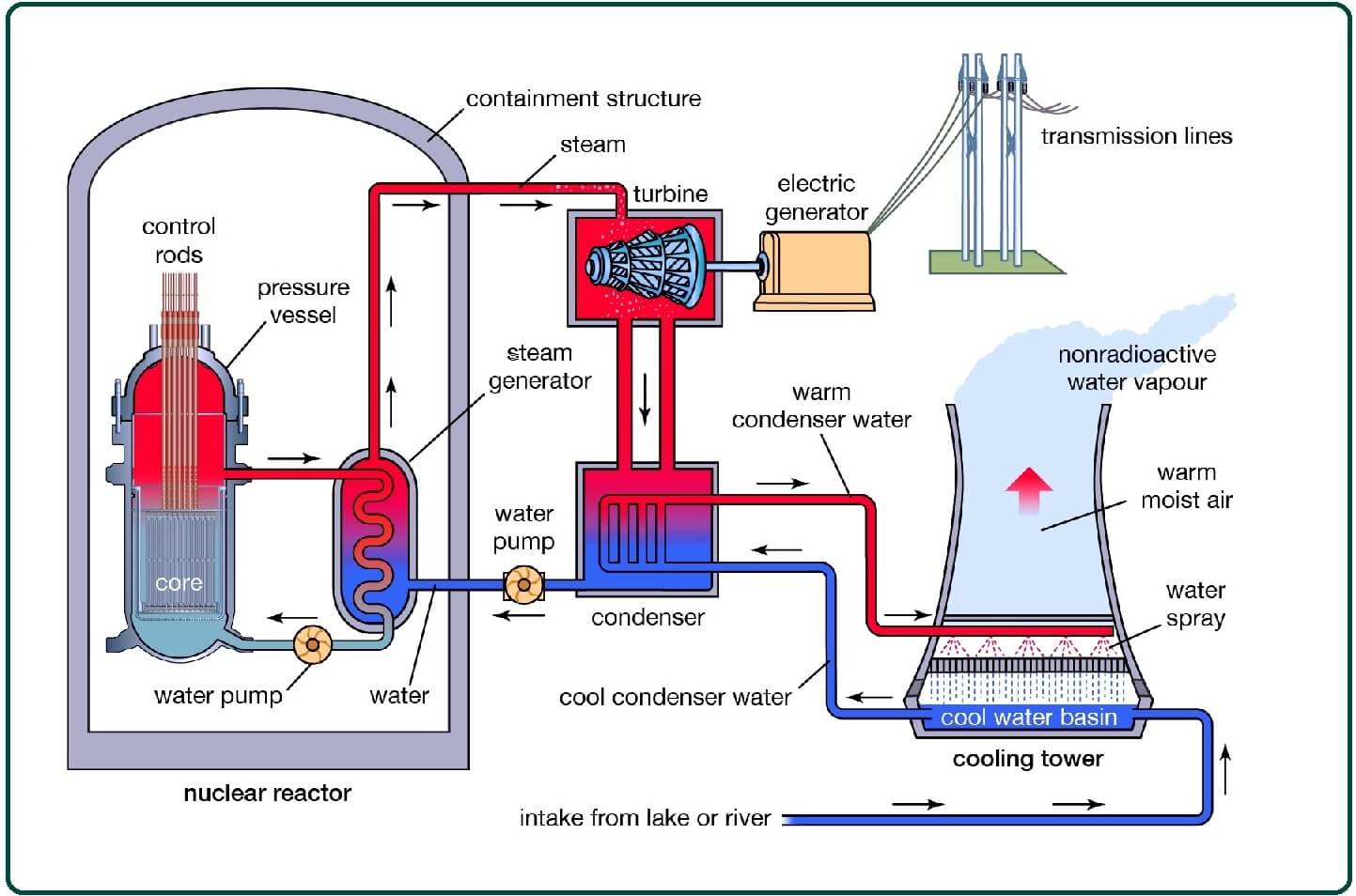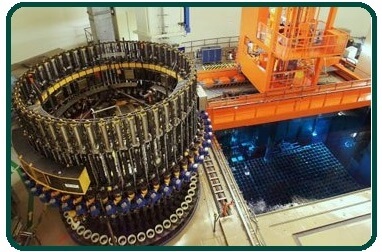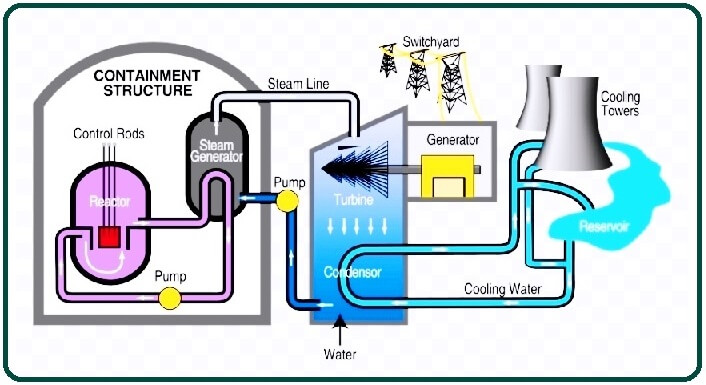Important Point
What Is a Nuclear Reactor?
Nuclear reactors are an essential system in nuclear power plants. They include nuclear drain reactions to generate heat using methods called fission. The heat generated can be used to make steam to spin the turbine. So that electricity can be generated.
Globally, there are hundreds of commercial reactors, with more than 90 reactors located in the United States. Hence nuclear power is one of the largest energy sources for reliable and carbon-free electricity.
How Does a Nuclear Reactor Work:
The main function of nuclear reactors is to control nuclear fission. The nuclear reactor working principles are nuclear fission, & it is a kind of method used to split atoms to generate electricity.
Nuclear reactors use uranium that will be processed into small ceramic pellets and jointly piled into fuel rods. A fuel combination can be formed by a group of more than 200 fuel rods.
Typically, a reactor core can be built through these assemblies depending on the power level. In a nuclear reactor vessel, the fuel rods are placed underwater.
So that it can act as a coolant as well as a mediator to help slow down the movement of neutrons. This neutron can be generated through fission to sustain the chain reaction.
After that, the control rods can be placed in the reactor core to reduce the rate of reaction. The heat generated through the fission process can convert water into steam to spin a turbine to generate carbon-free electricity.
Main Parts of Nuclear Reactor:
The essential components of a nuclear reactor mainly include the following. The nuclear reactor diagram is shown below.
#1. Core
The core in the reactor contains nuclear fuel to generate heat. This includes uranium with less enrichment, control systems, and structural materials. Shapes of the core are circular cylinders with a diameter of 5 to 15 m. The core includes several individual fuels pins.
#2. Reflector
Reflectors are arranged around the core to mimic the back of the neutrons flowing through the surfaces of the core.
#3. Control Rods
A nuclear reactors control rod is designed with heavy mass elements. Its main function is to absorb neutrons. So that it can continue or stop reactions.
The main examples of this rod are lead, cadmium, etc. These rods are mainly used to start the reactor, maintain the reaction at a constant level, and shut down the reactor.
#4. Containment
The control isolates the nuclear reactor from the surroundings. Typically, these are available in the shape of a dome and are designed with high-density & steel-reinforced concretes.
#5. Cooling Tower
This is used by some types of power plants to put off surplus heat that cannot be converted into heat energy due to thermodynamic laws. These towers are exaggerated symbols of nuclear power. These towers can only generate freshwater vapor.
#6. Mediator
The main function of a moderator in a nuclear reactor is to slow down neutrons from high energy levels as well as at high velocities.
So that increases the chances of the neutrons hitting the fuel rods. Modern moderators currently in use mainly include water H2o, heavy water D2o, beryllium, and graphite.
The properties of the moderator are high thermal stability, radiation and chemical stability, non-corrosiveness, etc.
#7. Coolant
The material used to transfer heat from the fuel to the turbine through the core, such as water, liquid sodium, heavy water, helium, or anything else, is known as a coolant.
The Coolant is mainly characterized by a low melting point, high boiling point, non-toxic, low viscosity, stability of radiation and chemical, etc. Commonly used Coolant is Hg, He, Co2, H2o.
#8. Turbine
The main function of a turbine is to transfer heat energy from the cooling device to electricity.
#9. Shielding
It protects working men from the effects of radiation. Particles such as alpha, beta, gamma, fast and slow neutrons can be formed in the fission process.
Therefore, to protect against these, thick layers of concrete or lead are used around the reactor. Alpha & betas particles can be stopped by using thick layers of plastic or metals.
Working of Nuclear Reactor:
First, some neutrons are created when alpha particles collide with polonium or beryllium. They are slowed down and used to initiate the fission of the U-235 nucleus. In this fission, fast-moving neutrons are released, which are further slowed to thermal velocity by a moderator.
These slow-moving neutrons cause the fission of more U-235, thus starting a chain reaction. By changing the depth of the control rod, the chain reaction is suitably controlled.
Also, Read: How Does Steam Generator Work? | What Is a Steam Generator? | What Is a Steam Boiler?
Nuclear Fission Creates Heat:
The main jobs of a reactor are to control and control nuclear fission – a process in which atoms split and release energy. Reactors use uranium for nuclear fuel. The uranium is processed into tiny ceramic pellets & stacked together into sealed metals tubes called fuels rod.
Typically, more than two hundred of these rods are joined together to form a fuel combination. A reactor core is usually composed of two hundred assemblies depending on the power level. Inside the reactor vessel, the fuel rod is immersed in water that acts as both a coolant and a moderator.
Moderators help to slow down neutrons produced by fission to maintain the chain reaction.
The control rods can then be inserted into the reactor core to reduce the reaction rate or retract to increase it. The heat created by fission turns water into steam, which spins turbines to produce carbon-free electricity.
Types of Light-Waters Reactors in the United States
All commercial nuclear reactor in the United States is light water reactors. This means that they use normal water as both a coolant and a neutron moderator. These are two types of light-water reactors operating in the US.
Pressurized Water Reactor:
More than 65% of commercial reactors in the United States are pressurized-water reactors or PWRs. These reactors pump water into the reactor cores under high pressure to prevent water from boiling. The water in the cores is heated by nuclear fission & then pumped into tubes inside the heat exchangers. Those tubes heat a separate waters source to create steams.
The steam then turns on an electric generator to generate electricity. The core water cycles the reactor back to heat, and the process is repeated.
Boiling Water Reactor:
Roughly thirds of the reactor operating in the United States is boiling water reactors (BWRs). BWRs heat the water and generate steam directly inside the reactor vessel.
Water is pumped through the reactor core and heated by fission. The pipes then feed steam directly to the turbine to generate electricity.
Nuclear Reactor Classification:
#1. By Nuclear Reaction
All nuclear reactor is based on the principle of nuclear fission & contain U-235 as nuclear fuels.
Nuclear reactors can be divided into two parts based on the energy of the moving neutrons controlling the nuclear chain reaction:
- The Thermal neutrons reactors used slow-moving or thermal neutrons to sustain the fissions chain reaction. These contain moderators that slow down the neutrons until their temperature becomes thermal.
- The fast neutron reactors use fast-moving neutrons to initiate fission reactions. These do not have moderators and use little or no moderating Coolant. The stability of the chain reaction requires the radioactive fuel to be richer in fissile material because of the lower probability of fission.
#2. Moderator Material
These are the following moderator materials used by the thermal reactor:
- Graphite moderator reactor
Water moderator reactors are further classified into two types:
- Commonly used heavy water reactors in Canada, India, China, etc.
- A light water reactor is the most common type of thermal reactor.
Light Element Moderator Reactor:
- Molten salt reactors (MSRs) operate by means of lighter elements such as beryllium and lithium, which are part of the refrigerant salts.
The liquid metal cooled reactor contains a coolant mixture of lead and bismuth.
Organically moderator reactors use biphenyls and terphenyls as coolants.
#3. By Coolant
- Water-cooled nuclear reactors: Many operational nuclear reactors are based on water-cooled reactors. As of 2014, 93% of the world’s nuclear reactors are water coolants based, and they account for 95% of total nuclear production.
- Liquid Metal Cooled Nuclear Reactors: Water is a moderator and cannot be used as a coolant in many fast reactors. So, the liquid metal refrigerant-based reactor is used, which contains sodium, lead, and mercury as Coolant.
- Gas-cooled reactors: An inert gas is used as a coolant in these reactors. Helium, carbon dioxide, and nitrogen are used as coolants in these reactors.
- Molten salt reactors (MSRs): This reactor is cooled by passing a molten salt (fluoride salt eutectic mixture) such as FLiBe.
#4. By Generations
- Generation 1 Reactors: They are research reactors, non-commercial current generating reactors.
- Generation 2 reactors: They are currently in use.
- Generation 3 reactors: They have been improved upon in the current design (1996–present).
- Generation 4 reactors: Technologie under development.
#5. By Phase of Fuel
- Use solids as fuel.
- Use the liquid as fuel.
- Use gas as fuel (practically not yet developed).
#6. By Shape of the Core
- In cubic shape.
- Cylindrical in shape.
- Octagonal in shape.
- Spherical in shape.
Uses of Nuclear Reactor:
- In the manufacture of radioisotopes used in scientific research, medicine, agriculture & industry.
- In the generation of electric currents.
- In the production of fasts, a neutron is used in a nuclear bombardment.
- In the production of fissile material such as plutonium which is widely used in atomic bombs.
Frequently Asked Questions (FAQ)
How Does a Nuclear Reactor Work?
The water in the core is heated by nuclear fission and then pumped into tubes inside a heat exchanger. Those tubes heat a separate water source to create steam. The steam then turns an electric generator to produce electricity. The core water cycles back to the reactor to be reheated, and the process is repeated.
How Do Control Rods Work in Nuclear Reactors?
A control rod is a device that is used to absorb neutrons so that the nuclear chain reaction taking place within the reactor core can be slowed down or stopped completely by inserting the rods further or accelerated by removing them slightly.
How Does a Submarine Nuclear Reactor Work?
Nuclear submarines and aircraft carriers are powered by onboard nuclear reactors. Atoms in the nuclear reactor split, which releases energy as heat. This heat is used to create high-pressure steam. The steam turns into propulsion turbines that provide the power to turn the propeller.
Main Parts of Nuclear Reactor
- Core
- Reflector
- Control Rods
- Containment
- Cooling Tower
- Mediator
- Coolant
- Turbine
- Shielding
Nuclear Reactor Classification
There are two basic types: the pressurized-water reactor (PWR) and the boiling-water reactor (BWR). In the PWR, water at high pressure and temperature removes heat from the core and is transported to a steam generator.
What Are Nuclear Reactors Used For?
Nuclear reactors are the heart of a nuclear power plant. They contain and control nuclear chain reactions that produce heat through a physical process called fission. That heat is used to make steam that spins a turbine to create electricity.
Uses of Nuclear Reactor
Nuclear reactors are primarily used for the generation of electricity; however, they can be used for propulsion in vehicles such as submarines or naval vessels, for the production of useful isotopes or neutrons, and for research and training. Nuclear reactors can be found all over the world.
Like this post?
Share it with your friends! Suggested Read –
- Parts of a Nuclear Power Plant
- Difference Between Orthogonal and Oblique Cutting | Orthogonal Machining
- What Is Magneto Ignition System | How Does an Ignition System Work | How Does a Magneto Work | What Does a Magneto Do | Magneto Ignition System
- What Is a Synchromesh Gearbox? | Principle of Synchromesh Gearbox | Construction of Synchromesh Gearbox | Working of Synchromesh Gearbox
- Working of Constant Mesh Gearbox | What Is a Constant Mesh Gearbox? | Different Gear Ratios in Constant Mesh Gearbox | Construction of Constant Mesh Gearbox
- What Is Cupola Furnace? | Cupola Furnace Design । Cupola Construction | Purpose of Cupola | Working Principle of Cupola Furnace: | Advantages of Cupola Furnace | Disadvantages of Cupola Furnace | Applications of Cupola Furnace





Leave a Reply